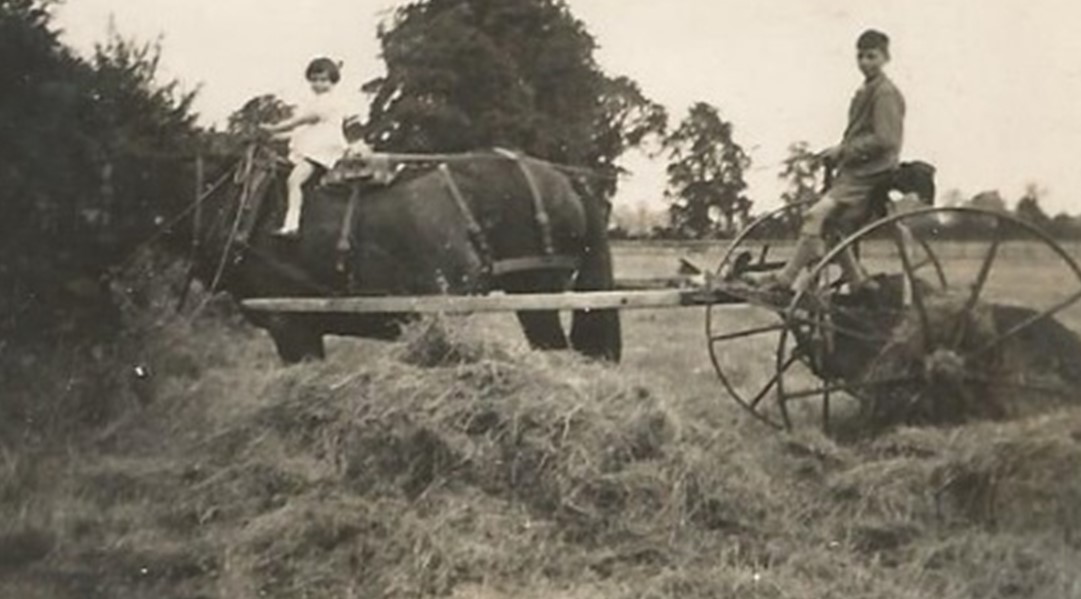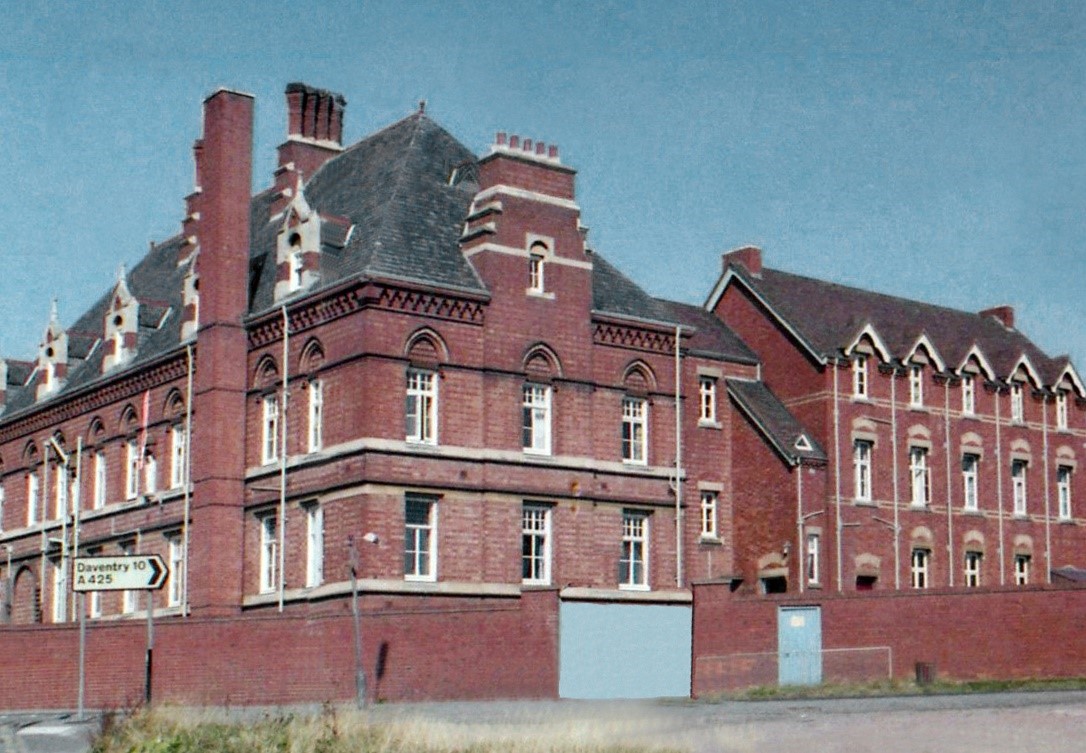Southam Convent was established in 1876 by the Sisters of the Poor Child Jesus originally from Aachen, Germany and the buildings that comprised the convent itself, its orphanage, school, and farm were on land off Daventry Road, now occupied by St Mary’s Primary School, and the St Wulstan Way housing. In this article, Mary Grant tells us about her time living at the Convent and becoming a pupil of the school in the 1930s.
I was born in 1931. My parents were Cyril and Mary Duckett and my father worked on the farm from the age of thirteen and my mother was an orphan from the convent. They married in 1924 and lived at Tollgate House.
Tollgate House had two bedrooms and I had to share one room with my two brothers. It was decreed that, by the age of three, I would have to leave home and sleep at the convent rather than with my siblings, so from the age of three to seven, I spent my nights in the children’s dormitory attic. At one end, an area was sectioned off for Sister Mary Martha, who supervised, ensuring a good night’s sleep with no giggling.
Lessons in the school varied. In The Retreat, the downstairs rooms were known as the study, which catered for the paying ‘boarders’. Subjects ranged from French to art to embroidery. Art was taken by Sister Mary Sales, Sister Mary Assumpta taught music and the head was Sister Mary John. When I was older I was able to study office skills such as typing and shorthand and, between the years of 1945 – 1948, I was in the dormitory with three friends: Ursula Wren, Wendy Freeman and Mary Higgin, whist waiting for the extra bedroom at our farm to be completed. These three friends stayed on at the convent to become nuns and all three trained to be teachers and taught at Southam.
The kitchen was enormous; it was situated at the lowest part of the building, along with the scullery, laundry, ironing and drying room and vegetable store. There was a huge coal range used for cooking and a dumb waiter used to carry the meals up to the nuns’ dining room on the second floor. In the cellar of The Retreat there was the dairy where hand-churned butter was made every Thursday. Upstairs was where racks of apples were stored, their sweet scent pervaded the whole building. At the rear was a small room facing the convent where the keeper of the keys lived.
At the rear was the Grotto and the beautiful statue of St Joseph. It was here, near the boiler room and the Head’s office, that Sister Donata raised and cared for a runt pig. To the side of the Grotto was the classroom and the playroom.
Along what is now St Wulstan Way, there was a cinder road made up of rubble and clinker, about eight feet wide, to allow for a horse and cart to travel to the top field to collect the hay. These fields were known as St Michael and St Raphael. There was no tractor to use on the farm to plough and the earth had to be dug and turned twice because of the heavy clay soil. This work was carried out by my father, Cyril, Sister Donata, Sister Angela and, ‘The Boss’ Sister Mary Arnolda.
I have many happy memories of the community and convent, where I was allowed to play freely as a young girl, and help Sister Donata and my father in the garden and on the farm.
This photograph shows Cyril Duckett collecting hay, with his sister Mary on the horse.

This photograph shows the original Convent buildings on the corner of Wood Street and Daventry Road.

Southam Heritage Collection has recently published a reprint of Mary Rock’s book: “Looking Back at The Sisters’ School” (which can be purchased online here or in our Exhibition Room) and our current exhibition also features the history of Southam Convent. You can find us in the atrium of Tithe Place, High Street, and we are open on Tuesday, Thursday, Friday and Saturday mornings from 10am to 12 noon. To find out more about Southam’s history, visit our website www.southamheritage.org telephone 01926 613503 or email southamheritage@hotmail.com You can also follow us on Facebook.

My brother and I lived at the convent between 1966-1968, we visited the site today for a trip down memory lane, so sad to see what is left of the place.
We both have very happy memories of the convent,probably the happiest of our childhood.
The nuns were so kind, I did revisit some years back and had tea in the retreat with the nuns,lovely.
Thanks for your feedback Kerry, we always appreciate any comments or feedback from people directly involved – I think most of us would agree with you how sad it was that the main buildings were pulled down. It would have been far better if they had been remodelled and turned into apartments at least. Thank you.
My great-great-aunt and uncle, Charles & Jane Carden, lived in Southam Hall from 1868-1875. Their youngest daughter wrote a memoir in which she remembered her happy years in ‘this small shooting box’. She and her sisters had lessons with Miss Pettifer, the postmistress. Their nurse used to take them for walks along the Leamington Road when their frocks were clean, but along the less smart Ladbrolke Road if they were dirty. She and her sisters returned some years later and were welcomed by the nuns, but they were sad to see that ‘a gigantic R.C. chapel’ had been built in the stable-yard. Her parents loved hunting and the stables were the centre of family life.
Thanks for your feedback Walter – do you happen to have a copy of the memoir that you mentioned – we would be very interested to take a look if you do have it.
Regards, Bernard
I was at the convent from 1952 with my sister we have very happy memories of the place. The nuns were lovely especially Sister Mary Cecila and Sister Clare Anthony Margaret and Patricia Maher
I was at the Convent in about 1958 with my sister. I remember Sister Cecilia. She was my favourite nun. I picked Cecilia for my confirmation name.
It’s great to get your feedback Krystyna, if there’s anything else you would care to add please do so or send us an email.
Myself, older sister ,younger sister and our little brother lived in fey house from late 60’s to early 70s and remember sister Donata who took care of the green house
We all have fond memories of our time there.
We all attended the school attached to the main convent and Sr clare de sailles and sister Joseph clare were both teachers there.
We were taken care of in Fey house by sister Mary Margaret and sister Joseph clare
We had a reunion with these nuns many years later.
I can honestly say that my time spent here was the best part of my childhood .We recieved an abundance of love and care from the sisters and have thought of southam practically every day since we left
That’s a lovely little story Patricia and thank you so much for sharing it with us. Do you have any photos or other documents from those days that you could share with us? We’re always interested in anything we can add to the Collection and sometimes its amazing what people like yourself have tucked away somewhere.
Bernard
I’ve come across this while looking at my family tree as two members became nuns at Southam, Kathleen Beagan who became Sr Mary Louise and her niece Catherine Jackson who became Sr Mary Rose. This would be in the 1930s and 40s. I’m very pleased to see it was a happy place.
Thanks for that information Kate, we know relatively little about the individual Sisters at the Convent, but I can see that a Sister Mary Louise died in 1950 at the relatively young age of 42 and is buried in the Convent graveyard, however there is no mention of a Sister Mary Rose, so I guess she must have moved on to another location. Do you know when the ladies joined the Sisters of the Poor Child Jesus and whether they both joined in Southam, perhaps after attending the school there? Regards, Bernard